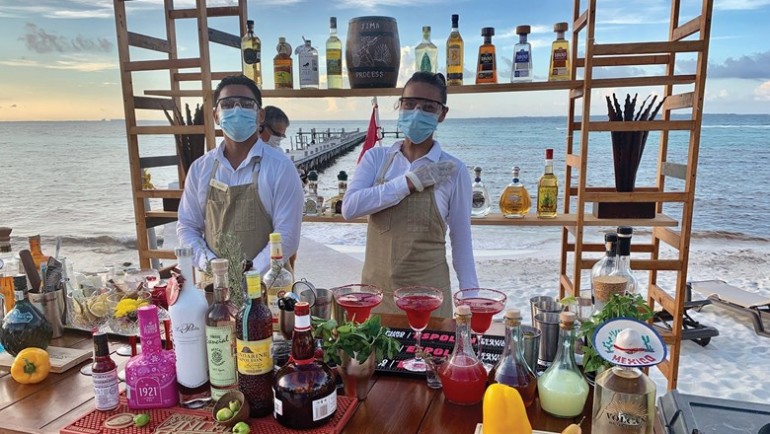Sponsored Listings:
When Mexico travel specialist Jennifer Doncsecz was invited to Cancun for an agent trip to the Hyatt Ziva in the midst of a pandemic, she admits she was hesitant, and she waited until the final moment to commit.
But like other advisors who have traveled to Mexico recently, Doncsecz, the president of VIP Vacations in Allentown, Pa., was impressed that the implementation of comprehensive health and safety protocols didn’t compromise her relaxing experience on the beach and made her feel she was safer than she was at home.

“We arrived on Tuesday, and by Wednesday afternoon, I actually had moments that I didn’t think about Covid — for the first time in four-and-a-half months,” she said. “I was like, this is really bizarre, I’m not worried about it.”
She now has plans to return over Labor Day.
As quarantine-weary Americans look to venture out, Mexico — despite high Covid-19 infection rates — has become the top international destination for near-term travel, sellers say. That’s likely due in no small part to proximity and that so few other countries, near or far, are currently welcoming Americans without restrictions.
Doncsecz’s sense that she was safer in Cancun than at home is the result of collaboration between Mexico’s resorts and tourism officials, who have worked closely with each other and local governments to adopt, enforce and publicize strict health and safety protocols.
“All of our hotels are now at the maximum allowed occupancy,” said Armin Kaestner, vice president of business development in the Americas and Caribbean for the Spanish all-inclusive company Riu. “It’s great and it’s not, because [allowable capacity] is only 30%.”
Still, he said, Mexico is booking at twice the rate of the company’s properties in Jamaica, the Dominican Republic, Aruba and the Bahamas.
The Cancun-Riviera Maya region has, by far, the country’s most hotel inventory of any beach destination, so it’s not surprising that it’s been the hands-down leader in gross bookings, according to advisors and packaged-tour operators. But Los Cabos last month reported the strongest recovery in international tourist arrivals on a percentage basis.
“Little by little, things have been getting back to normal. It’s very interesting,” said Rodrigo Esponda, managing director for the Los Cabos Tourism Board.
Figures from the Centro de Investigacion Competitividad Turistica Anahuac show international arrivals to Los Cabos in July were at 27% of their July 2019 levels, compared with 15% for Cancun and 18% for Puerto Vallarta.
While still dramatically lower than in 2019, they reflect dramatic improvements from the near 100% falloff recorded from April through June.
And travel sellers say that after dropping off a bit in early and mid-July, Mexico bookings picked up again dramatically in recent weeks and are second only to domestic travel.

Jack Richards, CEO of Pleasant Holidays, said that 51% of his company’s customers traveling between Aug. 1 and 10 were going to Mexico. And among those booking the destination July 1 to Aug. 3, 70% were for trips in 2020.
“It’s a lot of last-minute stuff,” he said. “We’re seeing people booking on Monday and departing on Tuesday.”
Ray Snisky, president of Apple Leisure Group Vacations, said their bookings for Cancun in August are down just 8% year over year.
“There’s a real push for people saying, ‘Let me get on this trip before summer ends,'” Snisky said. “I think this close-in booking trend will continue into the fall, although I don’t think it will be as dramatic as in the summer.”
Still, like everything Covid-19-related, the future remains unclear.
“This feels like a roller coaster ride,” said Richards. “You go down, you come up. Then you go down, then you come up.”
David Lavigne, director of product development and destination operations for Delta Vacations, agreed demand for Mexico “is a very fluid trend at this point.”
But “all in all, we continue to see a reasonable build for both short- and long-term business.”
Although airlift into Mexico for August is about half what it was at this time last year, according to aviation data firm OAG, travel sellers say it is sufficient given that hotels are currently capping occupancy at between 25% to 30% of maximum, depending on the state.
One thing that is helping Mexico, Snisky said, is that the majority of hotels in the major beach markets are open, and customers are more comfortable booking places that have some experience operating in the new environment and where they can be reassured about what the experience is going to be like.
They are also opting for more upscale properties, sellers said, with five-star properties selling at four-star prices.
Bill Linehan, president of Worldwide Marketing, said that, right now, the most popular products of client Karisma Hotels & Resorts on the Riviera Maya are the more expensive, private overwater bungalows and casitas. And customers are benefiting from upgrades, he said.
“What’s interesting is they are equating their value not just on price but quality, because they can get higher quality, greater value. And that’s where we’re benefiting.”
Source: travelweekly.com











Just curious about the Doncsecz’s flying experience, which is not mentioned. I thought the border between Mexico and the United States was closed. Was there any issues flying into Cancun or with leaving Allentown, Pa? Thanks.
The only restrictions on Mexico travel involve land crossings. While those are closed to all but essential travel until at least Sept. 21, there are no restrictions on air traffic between the two countries.